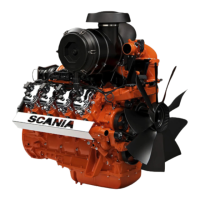INSTALLATION
MANUAL
© Scania CV AB 2018, Sweden
Batteries and alternators
03:01 Issue 11 en-GB 4
Safety during electric welding
When carrying out welding work on and near the engine, disconnect the battery and
alternator leads. Pull out the multi-pin connector for the engine control unit as well.
Connect the welding clamp as close to the welding site on the component as possible.
The welding clamp must not be connected to the engine, or so that the current can
cross a bearing.
When welding is finished:
1. Connect the alternator and engine control unit cables first.
2. Then connect the batteries.
Batteries and alternators
Batteries
Use lead batteries of the starter battery type. This type of battery is able to deliver
high current even at low temperatures for long enough for the engine to start.
Connect two 12 V batteries in series for 24 V system voltage.
If standard lead acid batteries are used, Scania recommends batteries with a starting
capacity of min. 160 Ah and a cold cranking amperage of 800 A for all engine types.
In warm climates in which the temperature only briefly falls below 0°C, batteries
with a starting capacity of min. 118 Ah and a cold cranking amperage of 490 A at
0°C may be used for all engine types.
The battery capacity indicates how high a current a battery can be discharged at for
20 hours at ambient temperature. A 100 Ah battery can, for example, be discharged
at max. 5 A for 20 hours.

